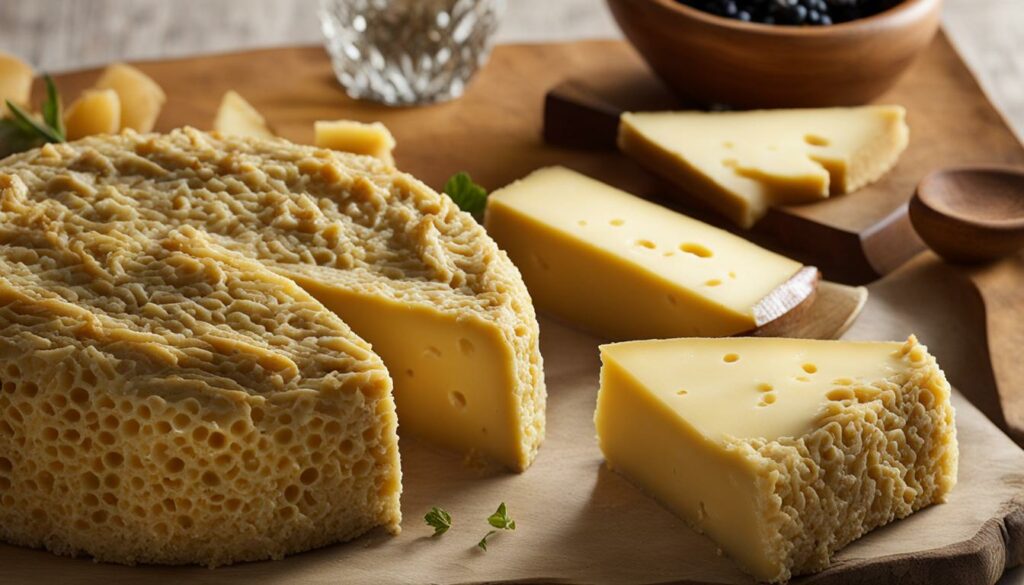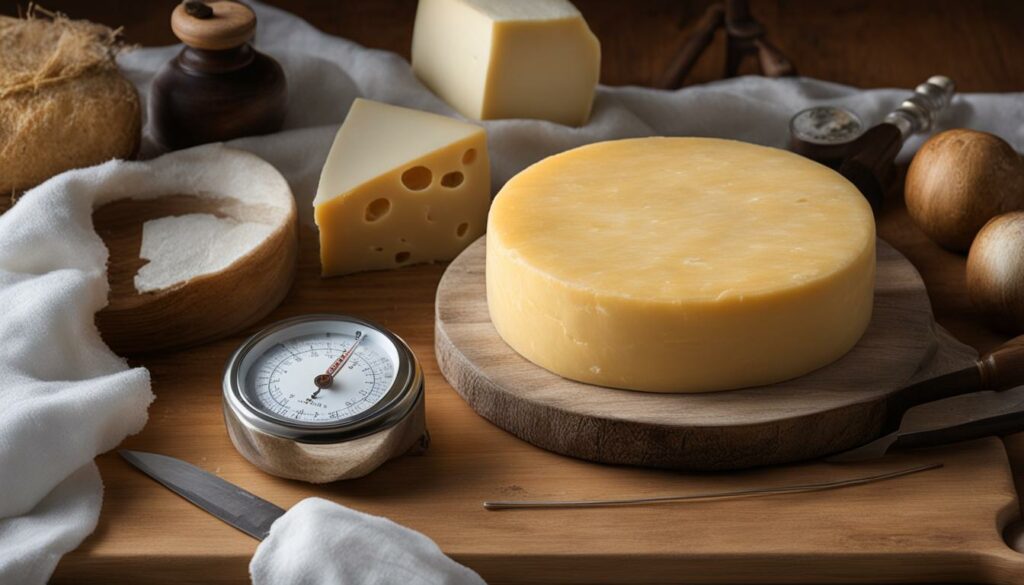Welcome to the world of Casu Marzu, a Sardinian specialty that embodies the essence of forbidden cheese. This risky delicacy is not for the faint-hearted, but if you’re looking for a truly unique and adventurous culinary experience, then buckle up.
Picture yourself savoring a cheese that challenges your senses and defies conventional norms. With its controversial production process and distinct characteristics, Casu Marzu is as intriguing as it gets.
While some may shy away from this unusual cheese, it continues to captivate the curiosity of adventurous food enthusiasts worldwide. So, if you’re ready to dive into the world of Casu Marzu, let’s unravel the mysteries and discover what makes it so exceptional.
The Creation and Production of Casu Marzu
Casu marzu, the renowned Sardinian delicacy, is a unique cheese with a fascinating production process. Made from rich sheep’s milk, this cheese undergoes a remarkable transformation through the introduction of cheese skipper flies and their larvae.
After the cheese is carefully crafted from sheep’s milk, it is left exposed to the cheese skipper flies. These flies are attracted to the cheese and lay their eggs inside it. Over time, the eggs hatch, giving birth to a colony of tiny larvae.
The larvae of the cheese skipper flies play a crucial role in the fermentation process. As they feed on the cheese, they break down the fats and proteins, resulting in a unique, creamy texture that sets casu marzu apart from other cheeses. This intricate interaction between the larvae and the cheese is what gives casu marzu its distinct flavor profile.
The fermentation process of casu marzu takes place over several months, allowing the larvae to fully develop and transform the cheese into a culinary masterpiece. This patient, time-consuming process is integral to the creation of this cherished Sardinian specialty.
Although the production of casu marzu may seem unconventional to some, it is a testament to the rich heritage and gastronomic traditions of the Sardinian people. This cheese showcases the profound connection between nature, culture, and the art of cheese-making.
The Fermentation Process of Casu Marzu at a Glance
| Step | Description |
|---|---|
| 1. Cheese Production | Sheep’s milk is used to create the base cheese for casu marzu. |
| 2. Exposure to Cheese Skipper Flies | The cheese is left exposed to cheese skipper flies to lay their eggs inside. |
| 3. Larval Hatching | The eggs hatch, and larvae emerge, initiating the fermentation process. |
| 4. Larval Feeding | The larvae feed on the cheese, breaking down fats and proteins for fermentation. |
| 5. Creamy Transformation | As the larvae feed, the cheese develops a creamy texture and distinctive flavor. |
| 6. Maturation | The cheese is left to ferment for several months, allowing the flavors to develop fully. |
| 7. Culinary Enjoyment | Finally, casu marzu is ready to be savored and enjoyed as a Sardinian delicacy. |
The unique creation and production process of casu marzu contribute to its status as a highly sought-after cheese and a symbol of Sardinian culinary tradition. Whether you are an adventurous food enthusiast or simply curious about the world of artisanal cheese, casu marzu offers an unforgettable gastronomic experience.
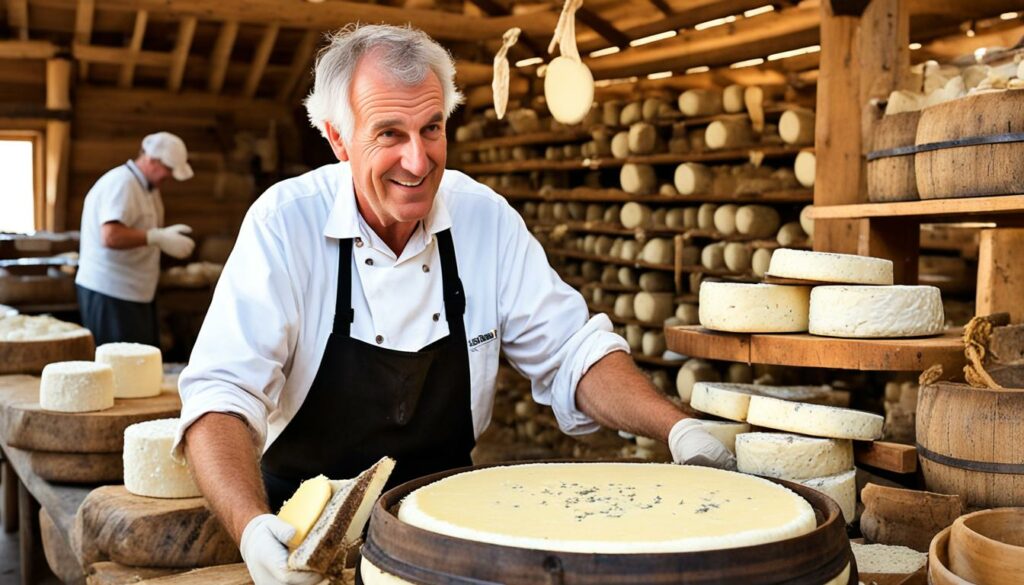
The Unique Eating Experience of Casu Marzu
Eating casu marzu is a truly extraordinary culinary adventure. The cheese is best enjoyed when the live maggots are still present, adding an unparalleled level of excitement and flavor to the experience. However, it is important to approach this unique delicacy with caution and follow proper eating techniques to ensure your safety and enjoyment.
The Art of Eating Casu Marzu
When indulging in casu marzu, it is advised to close your eyes as a precautionary measure to protect them from the jumping maggots. This can help avoid any potential discomfort or accidental injury. While it may seem counterintuitive, keeping your eyes closed ensures a smoother and more pleasurable dining experience.
Furthermore, proper chewing is crucial when consuming casu marzu. The cheese has a distinct texture due to the fermentation process caused by the maggots. Taking the time to chew thoroughly allows you to fully appreciate the unique combination of flavors that emerge as you savor every bite.
Flavor Accompaniments for Casu Marzu
To enhance the overall taste of casu marzu, it is common to pair it with various flavor accompaniments. Here are a few recommended options:
- Moistened flatbread: This serves as a neutral base that complements the rich, creamy cheese.
- Prosciutto: The saltiness of prosciutto adds a savory contrast to the cheese’s flavors.
- Melon: The refreshing sweetness of melon provides a delightful contrast to the intense flavors of casu marzu.
- Strong red wine: A robust red wine can help cleanse the palate between bites and enhance the overall tasting experience.
By combining casu marzu with these well-chosen accompaniments, you can create a harmonious balance of flavors that elevate the enjoyment of this unique cheese.
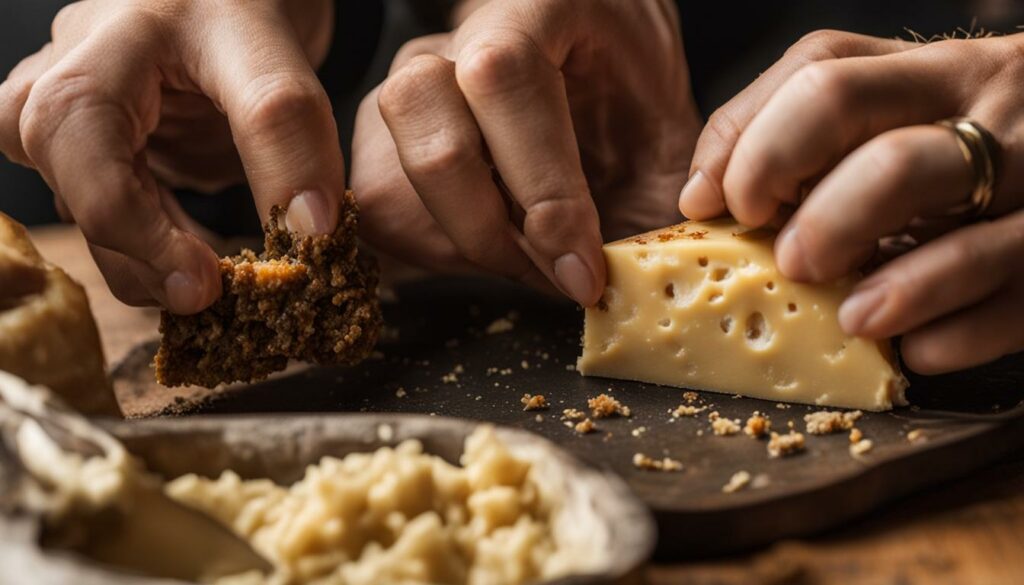
Now that you understand the unique eating experience of casu marzu, it’s time to dive in and savor the bold and intense flavors that this traditional Italian delicacy has to offer.
The Challenges of Acquiring Casu Marzu
Acquiring Casu Marzu, the infamous “banned cheese,” can be quite a daunting task due to the legal restrictions surrounding its sale and distribution. The European Union (EU) has banned the sale of this traditional Sardinian delicacy, making it nearly impossible to find outside of Sardinia itself.
Casu Marzu is protected as a heritage and traditional product of Sardinia, but selling it can result in significant fines. The strict legal regulations have created a thriving black market for this sought-after cheese. However, obtaining Casu Marzu through unofficial channels comes with its own risks and challenges. The authenticity, quality, and handling conditions may be questionable, compromising the heritage and tradition of this unique cheese.
“The sale of casu marzu has been banned by the EU, making it extremely difficult to find outside of Sardinia.”
Due to these legal restrictions and the potential risks associated with consuming Casu Marzu, the cheese is primarily enjoyed within the local communities of Sardinia and kept as a treasured delicacy for friends and family. This exclusive and intimate approach helps preserve its cultural significance and keep the tradition alive.
Legal Restrictions and Black Market
The ban on Casu Marzu by the EU is rooted in concerns about food safety and hygiene. The production process involving live maggots poses certain health risks, leading to the strict regulatory measures. Anyone caught selling or distributing Casu Marzu can face hefty penalties, reinforcing the underground trade and black market for this forbidden cheese.
The black market for Casu Marzu flourishes due to the high demand for this delicacy despite its legal status. However, indulging in the black market comes with inherent risks, including compromised quality and authenticity.
Preserving Heritage and Tradition
The legal restrictions and challenges surrounding Casu Marzu have inadvertently contributed to its preservation as a cherished cultural heritage. While it remains difficult to acquire, Sardinians take pride in producing and consuming this cheese within their communities, keeping the tradition alive and passing it down through generations.
By exclusively enjoying Casu Marzu among family and friends, they uphold the authenticity and integrity of this unique cheese. This preservation ensures that future generations can continue to appreciate and savor the heritage and tradition associated with Casu Marzu.

The Controversy and Potential of Casu Marzu
Casu marzu, the Sardinian specialty known for its unique production process, has sparked controversy due to the potential health risks associated with consuming live maggots. While some argue that the risk is minimal, especially when the maggots come from a controlled environment, others express concern about the potential hazards.
Nevertheless, in the quest for sustainability and alternative food sources, insects, including maggots, are being explored as a potential protein source for the future. As the world grapples with the environmental impact of conventional livestock farming, insects offer a more sustainable option. Maggots, rich in protein, can be produced with minimal resources and contribute to a more sustainable food system.
However, the acceptance of insects as a protein source, including maggots in casu marzu, faces social and cultural challenges. Despite the promising potential, cultural biases against consuming insects might hinder their widespread adoption as a protein source. Overcoming these challenges requires educating and familiarizing the public with the sustainability benefits and nutritional value of insect-based foods.
The controversy surrounding casu marzu highlights the ongoing exploration of sustainable protein sources and the need to balance the potential health risks with the environmental benefits. While further research and regulations are necessary, the future may hold more widespread acceptance and consumption of insect-based foods like casu marzu.
Health Risks and Safety Concerns
Consuming casu marzu, with live maggots present, presents potential health risks. The consumption of live insects can lead to infections, allergic reactions, or digestive issues. Therefore, caution must be exercised when consuming casu marzu to mitigate these risks. It is essential to ensure that the maggots come from a controlled environment, free from pathogens and harmful bacteria.
The Sustainability of Insects as a Protein Source
Insects, including maggots, offer a sustainable protein alternative with several advantages. Compared to traditional livestock farming, insect farming requires significantly fewer resources, such as land, water, and feed. Insects also have a lower carbon footprint and produce fewer greenhouse gas emissions. Additionally, the high protein content of maggots makes them an attractive option to address global protein demand while minimizing environmental impact.
| Benefits of Insects as a Protein Source | Challenges of Insect Consumption |
|---|---|
| 1. High protein content | 1. Social and cultural biases against insects as food |
| 2. Efficient resource utilization | 2. Ensuring safety and quality control |
| 3. Lower environmental impact | 3. Regulatory frameworks and standards |
“Insects have the potential to revolutionize the way we produce protein and achieve a more sustainable food system.” – Entomology expert, Dr. Emily Wilson
While the controversy surrounding casu marzu persists, it serves as a catalyst for discussions on alternative protein sources and sustainability. By addressing the health risks, regulatory challenges, and cultural barriers, the potential of insects as a sustainable protein source can be fully explored and embraced for a more sustainable future.
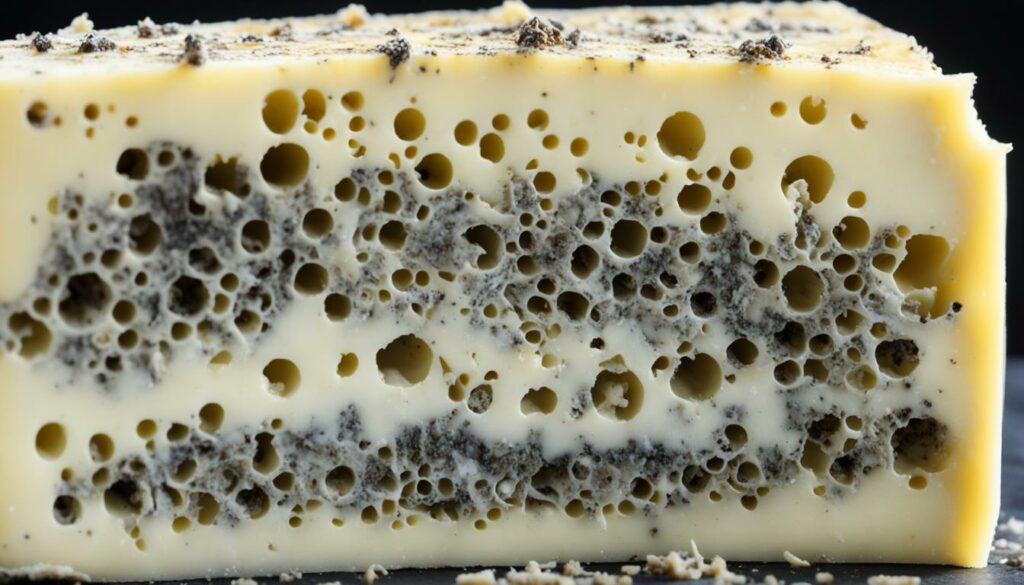
Conclusion
Casu marzu cheese is a unique and controversial delicacy from Sardinia. This traditional Italian cheese is known for its distinct flavor profile and cultural significance. Although it may be challenging to acquire and comes with health risks, it continues to captivate adventurous food enthusiasts.
The production and consumption of casu marzu are guided by tradition, making it a true Sardinian delicacy. The cheese’s fermentation process, facilitated by cheese skipper flies and their larvae, contributes to its creamy texture and intense taste.
While some may consider casu marzu a risky delicacy or even a forbidden pleasure due to the live maggots involved, others are fascinated by its unique eating experience. Accompanied by moistened flatbread, prosciutto, melon, or a glass of strong red wine, casu marzu entices the senses with its bold flavors.
FAQ
What is casu marzu cheese?
Casu marzu cheese is a traditional Italian cheese that originates from Sardinia. It is known for its unique production process and distinct flavor.
How is casu marzu made?
Casu marzu is made from sheep’s milk and is produced by exposing the cheese to cheese skipper flies. The flies lay their eggs inside the cheese, and the hatching maggots ferment the cheese over several months.
How should casu marzu be eaten?
It is recommended to consume casu marzu when the maggots are still alive. When eating, it is advised to close your eyes to protect them from the jumping maggots. Proper chewing and killing of the maggots is important to avoid potential health risks. Casu marzu is often enjoyed with moistened flatbread, prosciutto, melon, or strong red wine.
Why is casu marzu difficult to acquire?
The sale of casu marzu has been banned by the EU, making it extremely difficult to find outside of Sardinia. Selling the cheese can result in significant fines. As a result, casu marzu is primarily consumed within local communities and shared among friends and family.
What are the potential health risks of consuming casu marzu?
Consuming live maggots in casu marzu carries potential health risks. However, some argue that the risk is minimal, especially if the maggots come from a controlled environment.
Is casu marzu a sustainable food source?
Insects, including maggots, are being explored as a potential sustainable protein source for the future. While casu marzu is not widely consumed, it showcases the use of insects in the culinary world.

